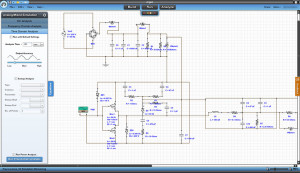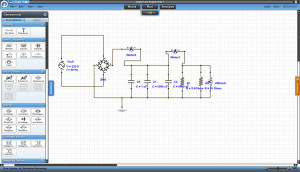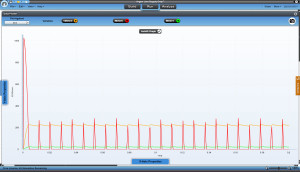I’ve been working on a project lately which involves building a large switch mode power supply in the range of 220 volts at 35 amps. Because components are expensive at those power levels I decided to go searching for a simulator that was easy to get started with, offered the basic components I needed and delivered results I could understand. I didn’t go digging really deep to be honest, but I found one that did what I needed and it’s been working out pretty good so far.
The web based application that I have been using is DoCircuits. DoCircuits basically has multiple levels of analog and basic digital simulation capability. They have the free version which allows up to 10 components, 50 simulations and 5 saved circuits a month or a ‘hacker’ level which is $2.99 a month paid a year in advance that allows unlimited components per circuit, 250 simulations per months and 50 saved circuits. And finally there is a ‘Geek’ level which is $3.99 a month with unlimited components, simulations and saved circuits. The Geek level also has a downloadable version of DoCircuits so you don’t have to work online.
This free account cool if you just need to test out a simple circuit or want to experiment with making stuff without having to pull out the soldering iron. The one thing that I like about DoCircuits was that they had an IGBT component listed in there so I was able to mess around with some IGBT drive simulations to see how they might work out.
After doing about 20 simulations it temporarily kicked me up to the Hacker level so I started putting in a large switch mode PSU system to see how that worked out. You can see it in the picture below.
One thing that strikes me as odd, and I don’t know if this is really a limitation of the simulator, or my lack of understanding of simulators, is that it requires a circuit ground. The Circuit on the SMPS side is all floating and ungrounded, but in order to get it to simulate properly, it demanded a ground be placed, so I stuck it on the -HVDC line, which may affect my simulation. Any suggestions for a way around this would be appreciated.
The simulator worked great so far in that I was able to simulate the Input side of the power supply which just happened to consist of 10 components (including the meters) That circuit is shown below.
And then when I ran the simulation on the circuit for a 1/5th of a second, I could see the results and what I could expect from the actual circuit in a perfect world, assuming all of my values were as indicated in the schematic. The initial inrush current through IMeter0 to the chargins caps was over 1000 Amps that last 3.47ms and then drops down to 268 amp peaks at 120Hz which are 8.33ms apart (120Hz) resulting in in a voltage ripple of about 13.294 volts (227.407 > 214.113) on the load of 10 Ohms in this case. The current through the 10 ohm load varies from 22.786 to 21.454 amps, or by about 1.3 Amps. This is just an example circuit, and it gives me something to start with and experiment with for my switched supply.
I don’t know how accurate any simulation is, and I think stuff needs to be tested in the real world with a scope to make a final determination, but I think these things will get you close before you start spending money on components.
Another thing I like is how easy it is to tie in and configure the many different pieces of equipment, voltage/current sources, pulse sources and the like. For parts of the circuit which the components don’t exist, such as a PWM driver chip, I can create a pulse generator to take it’s place. There is also a formula editor for generating your own reactions, or something to that effect, I haven’t really dug into that part yet.
Well, of course once I got a bunch of this in, well over 10 components, the program kicked back over to Free License mode and I couldn’t actually simulate this how I wanted. If you’d like to help me in simulating this circuit and the other stuff I want to do, please check out DoCircuits.com by clicking this link, it’s a referal link and each person who signs up will give me 15 more days at the hacker level and I would greatly appreciate it.
Now, I do realize that $2.99 is cheap, I just don’t want to pay for a whole years worth, to find out a month or two later that there’s a better option out there for simulating circuits. I think at least a 1 month trial period at the $2.99 level would really let me improve my knowledge of the workings of the simulator and decide if I want to spend the money for a years membership. Quarterly memberships would be great also, but they probably would have to raise the prices.
If you know of any other good circuit simulation web apps or programs that are free or very cheap that has good support for many of the components used in power system simulation please let me know and I will check it out as well. Support for IGBTs is important to me, many of the sims didn’t have them.




Leave a reply to Web Based Circuit Simulation